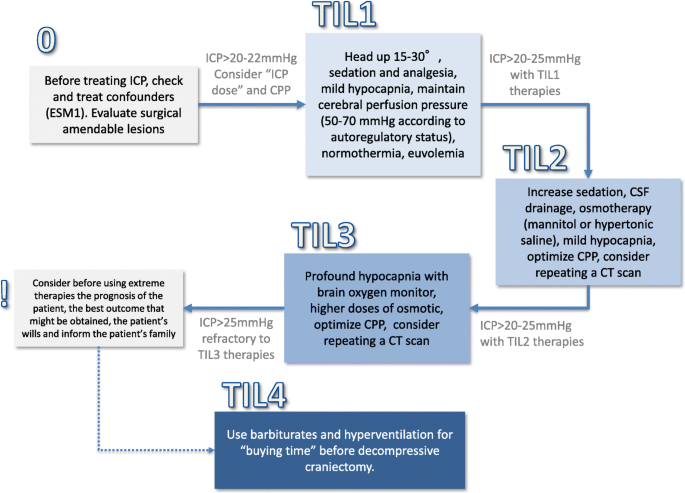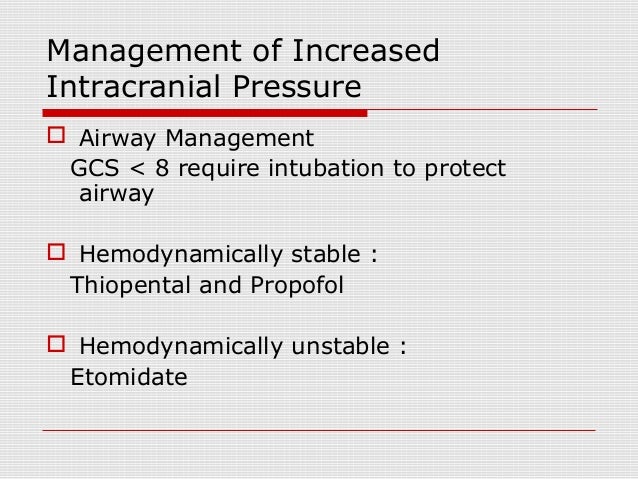This can be done by slowing down production of it within the ventricles of the brain. I don t recommend usage of diuretics especially in patients with concurrent venous pathology as this may increase risk of thrombosis due to preexisting slow outflow.
New Therapies For Intracranial Hypertension
Therefore the ultimate treatment goal should be the placement of an icp monitoring device.

Treatment of increased intracranial pressure. Outcomes and intracranial pressure data from the traumatic coma data bank suggest that icps over 20 mm hg particularly if sustained lead to worse outcomes this has been corroborated by several other large studies most recently an analysis of 846 tbi patients which showed that mortality rates were 14 if icp was 20 mm hg by 48 hrs but. It discusses the reasons to monitor intracranial pressure and describes methods available for the treatment of intracranial hypertension. Conservative treatment for intracranial hypertension.
Surgical treatment of elevated intracranial pressure surgical techniques that address elevated intracranial pressure include 1 intraventricular catheter insertion and cerebrospinal fluid drainage 2 removal of an intracranial space occupying lesion and 3 decompressive craniectomy. Effective treatments to reduce pressure include draining the. A raised intracranial pressure is defined as one above 20 mmhg.
The initial phase of head injury is often accompanied by significant increases in brain bulk. References for the work are included at the bottom. Treatment with acetazolamide or beta blockers may be used to reduce the csf and blood pressures.
Diagnosis and treatment management including patient monitoring. Therapy of increased intracranial pressure monitoring the patient with raised icp although early interventions will often be performed without direct monitoring of raised icp therapies are reversible. The most urgent goal of treatment is to reduce the pressure inside your skull.
The next goal is to address any underlying conditions. Definition of increased intracranial pressure intracranial pressure is usually less than or equal to 15 mmhg in the adult patient and slightly lower in children. This chapter discusses diagnosis monitoring and treatment of increased intracranial pressure.
Treatment with osmoactive agents such as mannitol or hypertonic saline hts solutions is widely used to manage or prevent the increase of intracranial pressure icp in central nervous system cns disorders. Treating icp with medication one way to manage icp is to reduce the volume of cerebrospinal fluid csf in the intracranial space under the skull.
 Troubled Mind The Lowdown On Increased Icp Ems World
Troubled Mind The Lowdown On Increased Icp Ems World
 Critical Care Management Of Increase Intracranial Pressure Ppt Video Online Download
Critical Care Management Of Increase Intracranial Pressure Ppt Video Online Download
 The Algorithm For Treatment Of Increased Intracranial Pressure Icp In Download Scientific Diagram
The Algorithm For Treatment Of Increased Intracranial Pressure Icp In Download Scientific Diagram
 Idiopathic Intracranial Hypertension Consensus Guidelines On Management Journal Of Neurology Neurosurgery Psychiatry
Idiopathic Intracranial Hypertension Consensus Guidelines On Management Journal Of Neurology Neurosurgery Psychiatry
 The Algorithm For Treatment Of Increased Intracranial Pressure Icp In Download Scientific Diagram
The Algorithm For Treatment Of Increased Intracranial Pressure Icp In Download Scientific Diagram
New Therapies For Intracranial Hypertension
 The Algorithm For Treatment Of Increased Intracranial Pressure Icp In The Neuro Intensive Care Unit N 52
The Algorithm For Treatment Of Increased Intracranial Pressure Icp In The Neuro Intensive Care Unit N 52
 Staircase Approach To The Treatment Of Increased Intracranial Pressure Download Scientific Diagram
Staircase Approach To The Treatment Of Increased Intracranial Pressure Download Scientific Diagram
 Raised Intracranial Pressure Paediatric Emergencies
Raised Intracranial Pressure Paediatric Emergencies
Raised Intracranial Pressure What It Is And How To Recognise It Roytowski Continuing Medical Education
 The Child With Raised Intracranial Pressure Chapter 19 Managing The Critically Ill Child
The Child With Raised Intracranial Pressure Chapter 19 Managing The Critically Ill Child
 How I Manage Intracranial Hypertension Critical Care Full Text
How I Manage Intracranial Hypertension Critical Care Full Text
Jornal De Pediatria Print Page
